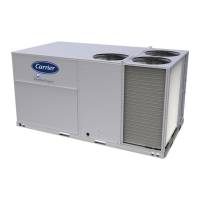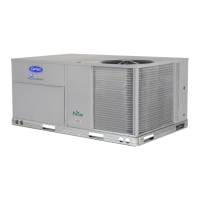26
Fig. 28 — Completed Hood Assembly
Step 9 — Install Flue Hood and Combustion Air
Hood
The flue hood is shipped screwed to the fan deck inside the burner
compartment. Remove the burner access panel and then remove
the flue hood from its shipping location. Using the screws provid-
ed, install flue hood in the location shown in Fig. 29.
The combustion air hood is attached to the back of the burner ac-
cess panel. Remove the two screws securing the hood to the back
of the burner access panel. Using the two screws, re-attach the
hood to the front of the burner access panel as shown in Fig. 29.
Fig. 29 — Flue Hood and Combustion Air Hood
Details
Step 10 — Install Gas Piping
Installation of the gas piping must be in accordance with local
building codes and with applicable national codes. In U.S.A., refer
to NFPA 54/ANSI Z223.1 National Fuel Gas Code (NFGC). In
Canada, installation must be accordance with the CAN/CSA
B149.1 and CAN/CSA B149.2 installation codes for gas burning
appliances.
This unit is factory equipped for use with natural gas (NG) fuel at
elevations up to 2000 ft (610 m) above sea level. Unit may be field
converted for operation at elevations above 2000 ft (610 m) and/or
for use with liquefied petroleum (LP) fuel. See accessory kit in-
stallation instructions regarding these accessories.
NOTE: Furnace gas input rate on rating plate is for installation up
to 2000 ft (610 m) above sea level. In U.S.A. the input rating for
altitudes above 2000 ft (610 m) must be derated by 4% for each
1000 ft (305 m) above sea level.
For natural gas applications, gas pressure at unit gas connection
must not be less than 5 in. wg (1246 Pa) or greater than 13 in. wg
(3240 Pa) while the unit is operating (see Table 3). For liquified
petroleum applications, the gas pressure must not be less than
11 in. wg (2740 Pa) or greater than 13 in. wg (3240 Pa) at the unit
connection (see Table 4).
Manifold pressure is factory-adjusted for natural gas (NG) fuel
use. Adjust as required to obtain best flame characteristics (see
Table 5). Manifold pressure for liquid propane (LP) fuel must be
adjusted to specified range (see Table 6). Follow instructions in
the accessory kit to make initial readjustment.
Install a gas supply line that runs to the unit heating section. Refer
to the NFPA 54/NFGC or equivalent code for gas pipe sizing data.
Do not use a pipe smaller than the size specified. Size the gas sup-
ply line to allow for a maximum pressure drop of 0.5 in. wg
(124 Pa) between gas regulator source and unit gas valve connec-
tion when unit is operating at high-fire flow rate.
The gas supply line can approach the unit in two ways: horizontal-
ly from outside the unit (across the roof), or through unit basepan.
Observe clearance to gas line components per Fig. 30.
FLUE HOOD
COMBUSTION
AIR HOOD
Table 3 — Natural Gas Supply Line Pressure Ranges
UNIT MODEL UNIT SIZE MIN MAX
48LC** 14, 17, 20, 24, 26
5.0 in. wg
(1246 Pa)
13.0 in. wg
(3240 Pa)
Table 4 — Liquid Propane Supply Line Pressure
Ranges
UNIT MODEL UNIT SIZE MIN MAX
48LC** 14, 17, 20, 24, 26
11.0 in. wg
(2740 Pa)
13.0 in. wg
(3240 Pa)
Table 5 — Natural Gas Manifold Pressure Ranges
UNIT MODEL UNIT SIZE HIGH FIRE LOW FIRE
48LC** 14, 17, 20, 24, 26
3.0 in. wg
(747 Pa)
2.0 in. wg
(498 Pa)
Table 6 — Liquid Propane Manifold Pressure Ranges
UNIT MODEL UNIT SIZE HIGH FIRE LOW FIRE
48LC** 14, 17, 20, 24, 26
11.0 in. wg
(2740 Pa)
7.3 in. wg
(1818 Pa)
48LCS* 14 only
9.8 in. wg
(2441 Pa)
6.5 in. wg
(1619 Pa)
CAUTION
EQUIPMENT DAMAGE
Failure to follow this caution may result in equipment damage.
When connecting the gas line to the unit gas valve, the installer
MUST use a backup wrench to prevent damage to the valve.

